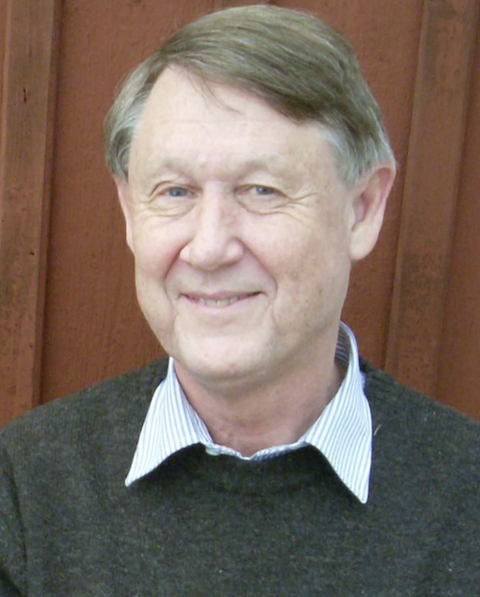
Toine Egberts
Utrecht Institute for Pharmaceutical Science,
Division of Pharmacoepidemiology and Clinical Pharmacology,
Utrecht University & Department of Clinical Pharmacy,
University Medical Center Utrecht, the Netherlands

Ronald Meyboom (far right) smiles at the camera with Bruno Stricker (far left) and Cecilia Biriell (middle) in the early days
Ronald Meyboom, pioneering pharmacovigilance expert who helped establish drug safety monitoring in the Netherlands, died 27 April. He was 79.
Ronald Meyboom (Ron or Ronnie as he liked to be called) was born in Amsterdam, the Netherlands on 16 March, 1945. He was married to Julie de Maes Janssens and had two sons and three grandchildren. After completing his medical training at Leiden University in 1973, he was appointed as Inspector of Public Health and Director of the Netherlands National Pharmacovigilance Centre. He also contributed part-time to patient care as a clinical consultant on drug-related diseases at the Leiden University Hospital and was actively involved in various committees and advisory boards, including serving as a member of the standing committee on adverse reactions and vaccines of the Dutch Health Council.
On the international stage, Ron played a pivotal role in pharmacovigilance in many functions and capacities. He served as a member of the advisory committee of Uppsala Monitoring Centre (UMC) in its early years and continued to work as a consultant for the centre, focusing particularly on haematological reactions and signal detection methodology. He was a founding board member of the European Society of Pharmacovigilance and served as a member of the pharmacovigilance working party of the European Commission. He was distinguished as an honorary member of the International Society of Pharmacovigilance.
In the early 90s, he was involved in the development of a nationwide network of regional centres for adverse drug reaction reporting, which later became the Netherlands pharmacovigilance centre Lareb. In 1998 he obtained his PhD degree at the University of Nijmegen on his thesis “Detecting Adverse Drug Reactions – Pharmacovigilance in the Netherlands”, focusing on principles of signal detection and causality assessment. Before formally retiring, Ron actively participated as a researcher at the division of pharmacoepidemiology and clinical pharmacology of Utrecht University, sharing his knowledge with PhD students and other researchers. He also understood the critical need to foster strong relationships with the field, encouraging healthcare professionals—both physicians and pharmacists—to report unusual and significant events.

Ron was an original thinker and aware of the importance and power of knowledge sharing. During his time at UMC, Ron was integral to developing its approach to education and its delivery worldwide. He published more than 100 papers, case reports, and series while he served on the editorial board of the journal Drug Safety. His seminal pharmacovigilance papers such as "New strategies for drug monitoring" (BMJ 1977), "Signal selection and follow-up in pharmacovigilance" (Drug Safety 2002), "ABC of drug-related problems" (Drug Safety 2000), and "Causal or casual; the role of causality assessment in pharmacovigilance" (Drug Safety 1997), are still used as teaching material for beginners and advanced professionals working in pharmacovigilance.
“Signal detection was such a big part of who Ron was. Even after a full day of work at UMC, Ron would head out to the pub with a stack of anonymised ICSR reports in a plastic bag, and sit with a beer in hand, humming away as he worked through them well into the night.”
Ron was one of the very first “pharmacovigilantes”, having begun his career in pharmacovigilance just as the field was taking off following the aftermath of the thalidomide tragedy. He meticulously analysed safety cases, actively sought follow-up information whenever necessary, and had an exceptional eye for detail and an outstanding memory for remarkable analogies, particularly when biologicals entered the clinic. He had a nose for unusual patterns and interesting and relevant new safety information. As the number of medicines safety reports rose significantly both in the Netherlands and worldwide, Ron recognised the potential of computerised algorithms for signal generation—including those related to drug-drug interactions and syndromes—long before this approach became mainstream thinking. At the same time, he would always tell students to maintain a strong clinical focus by checking the underlying case reports as a complement to an epidemiological and statistical perspective on medicines safety. Ron was also among the first to see the usefulness of the patient perspective in monitoring the safety of medicines, and always kept the patient’s journey in mind.
“Early in [Ron’s] career he often made physical visits to patients who had suffered adverse reactions, to provide help if required, and to learn as much as possible about the event to be able to help prevent similar problems happening to other patients. This diligence was maintained throughout his career. When he was no longer able to maintain physical visits, he searched for information in libraries and the internet with a critical mind and attention to detail equal to a modern-day Sherlock Holmes.”
For young colleagues and students, Ron was a mentor who enthusiastically conveyed the importance of pharmacovigilance. He spoke with genuine passion about unusual cases, bringing them to life in a way that was thought-provoking, inspiring, and full of humour. He had so many ideas even long after his retirement that ex-colleagues would often receive phone calls beginning with "Hi, Ron here, listen…."
Ron passed away on 27 April. We lost a passionate scientist and teacher who always placed the medical and patient perspective at the core of pharmacovigilance.
Oman’s VigiMobile launch is more than a technical upgrade. It signals a strong commitment to patient safety and public participation in pharmacovigilance.
17 September 2025
How can we make healthcare safer for children? ISoP’s Angela Caro-Rojas shares insights ahead of World Patient Safety Day.
04 September 2025
Prof. Singhal passed away on 19 April 2025. He is survived by his wife, children, and a large community of pharmacology researchers who had the privilege of training under him.
02 July 2025